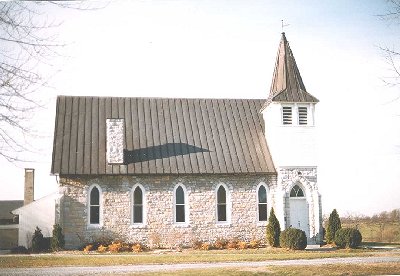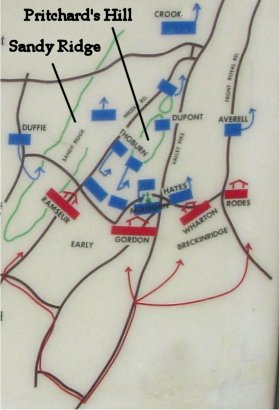

Second Kernstown
July 24, 1864
After Hunter's Raid through the Shenandoah Valley toward Lynchburg was repulsed, Jubal Early and his reinforced Second Corps moved north through the Valley and advanced on Washington, D.C. Because of various delays, the Battle of Monocacy, and Union reinforcements, Early failed to take the city. The Confederates fell back to the Valley, pursued by a force under Horatio Wright composed of the VI Corps and part of the XIX Corps. Early turned on his pursuers at Cool Spring just west of the Blue Ridge on July 18th, but withdrew south to Strasburg after learning of a Union force advancing toward his rear from the north. A Confederate division under Ramseur intended to cover Early's retreat was defeated by Averell at Rutherford's Farm north of Winchester on July 20th.
Crook now commanded Union forces in the Valley, but with Early's retreat south, it was assumed that the Confederates were leaving the Valley, so Wright began returning to Washington with his men with a view to returning to Petersburg. This left 12,000 Federals at Winchester under Crook to defend against 17,000 Confederates under Early. Crook knew that he didn't have enough men to defend against Early, but he thought that Early had left the area, and he would stubbornly refuse to accept evidence to the contrary. Indeed, Early had considered returning to Lee at Petersburg, but he suspected that he could be of greater use in the Valley by diverting Union troops away from Lee. To accomplish that goal, and a see what he was up against, he advanced.
When Early's cavalry began skirmishing with the Union cavalry screen south of Winchester - and pushing them back - Crook sent his infantry south to Kernstown, where Pritchard's Hill dominated the area. With the close contact with the Union army, Early discovered that he outnumbered his opponent. He decided to attack the next morning, July24th.


Opequon Church
Early on the morning of the 24th, Confederate cavalry pushed the Yankees back to Pritchard's Hill at Kernstown. With possession of Barton's Woods, south of modern Apple ___ Road, Early was able to keep Gordon's Division hidden there west of the Valley Pike. East of the Valley Pike, Wharton's division of Breckinridge's command deployed under the cover of a ravine. Crook, therefore, was unaware that he faced anything more than cavalry, so he ordered Col. Mulligan's division south from Pritchard's Hill, past Opequon Church toward Barton's Woods to push them away. Mulligan was repulsed, and returned to the foot of Pritchard's Hill reporting that he faced a sizeable enemy. Still in denial of the situation, Crook ordered Mulligan forward again, with Rutherford B. Hayes supporting him east of the Valley Pike, and Averell's cavalry further east intended to cut off the Confederate retreat. To the west, Thoburn's division would support Mulligan by advancing along Sandy Ridge.
Mulligan's Federal division deployed at the foot of Pritchard's Hill west of Kernstown and sent skirmishers forward to Opequon (pronounced Oh peck un) Church. This church, about 2,000 feet west of the Valley Pike, would become scene to bitter fighting.

From Opequon Church
This is the view looking north to west from Opequon Church. Pritchard's Hill is to the right. Near the foot of the hill Mulligan's division deployed, while DuPont's artillery deployed further back on the hill for support. Duval's and Thoburn's men deployed at the foot of the hill further west in an area blocked from view by the hill. Future President Rutherford B. Hayes deployed his men off the picture to the right on the east side of the Valley Pike.
About noon, the Confederate army began their attack. Gordon's division pushed back the Union skirmishers, but the Union infantry advanced in response and formed a line based on the church through the open field extending to Sandy Ridge - the wooded ridge in the distance. A brigade of Gordon's division pushed back the Yankees in the center of the field and near the church. Ramsuer's division was advancing on the Federals close to Sandy Ridge while Wharton's and Rodes' divisions were threatening the other Union flank east of the Valley Pike. Hayes' men could not stand the flank attack and fell back. Mulligan's division was now threatened in front and on both flanks and broke. The Union troops streamed to the rear with Hayes and Thoburn covering the withdrawal of the artillery while cavalry on the western flank attacked to buy time.
The Union army lost 1,185 of its 9,500 men while Early lost just 600 of his 14,000. Just days after the battle, McCausland's cavalry burned Chambersburg in retaliation for Hunter's depredations in the Valley. Jubal Early was once again acknowledged as a threat and the Union VI and XIX Corps were returned to the Valley and Phil Sheridan was placed in command.
topo map Pritchard's Hill is just north of "Old Opequon Church. The large four lane road passes over Sandy Ridge. Thoburn's and Duval's divisions deployed originally along the southwestern foot of Pritchard's Hill and moved out to just beyond the orchard. Hayes' line extended from Rt. 11 through the large purple rectangle.
Back to Civil War Virtual Battlefield Tours